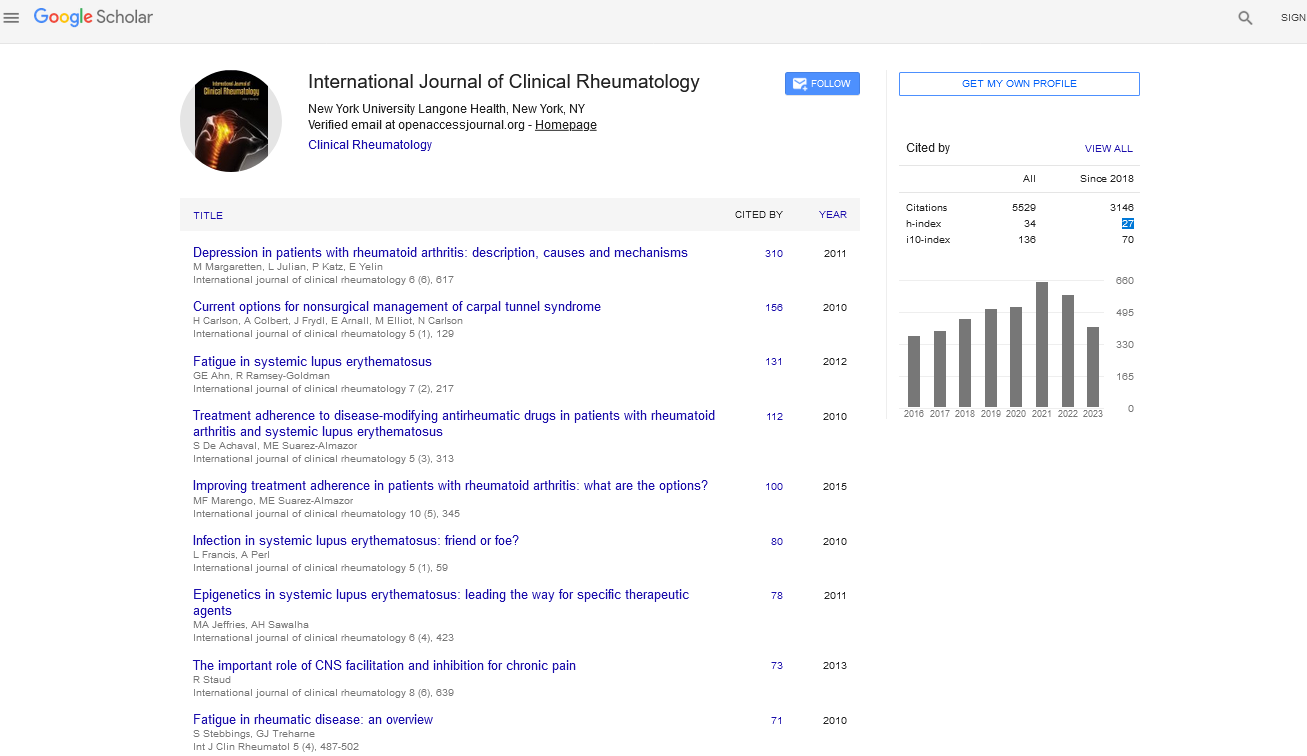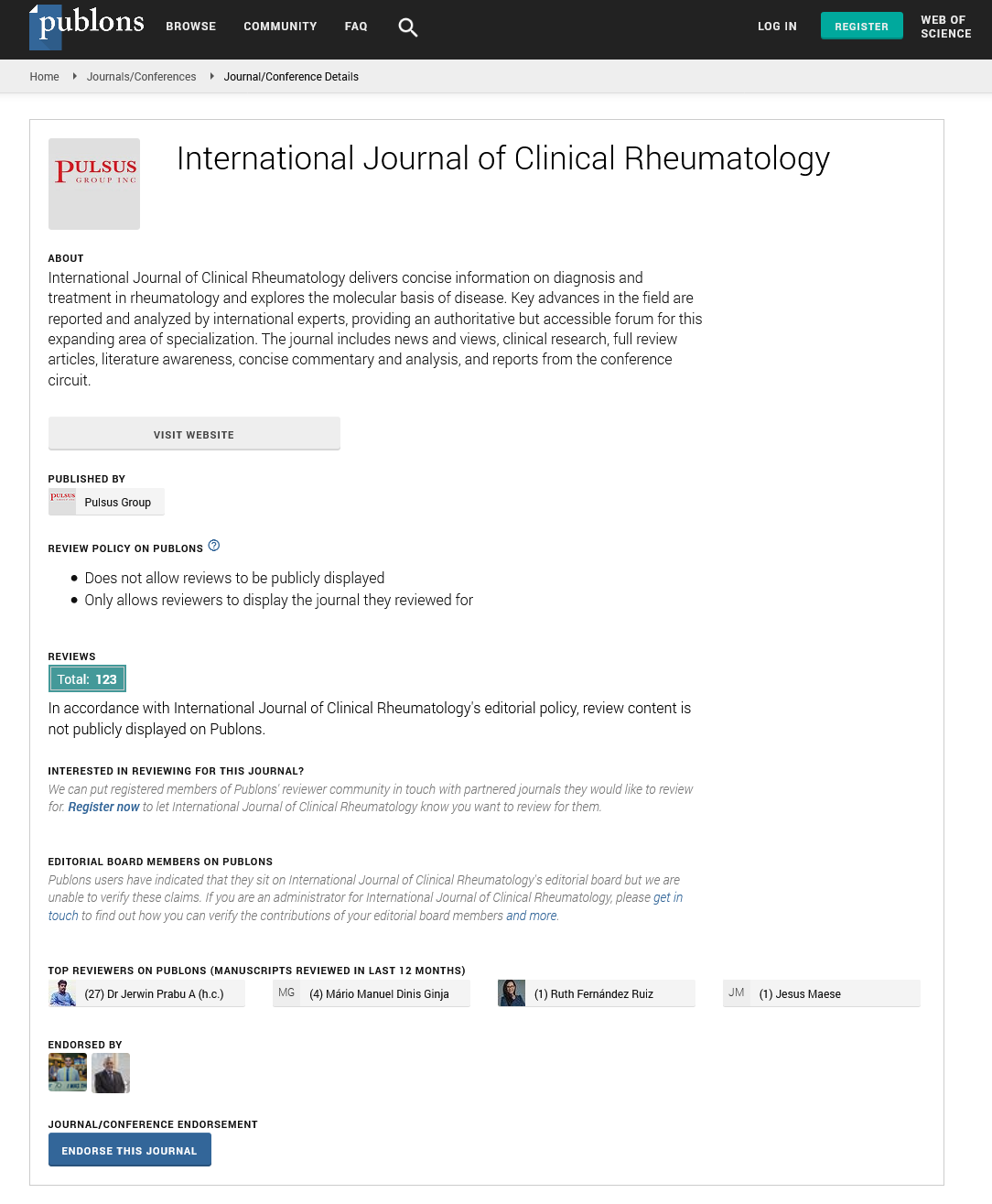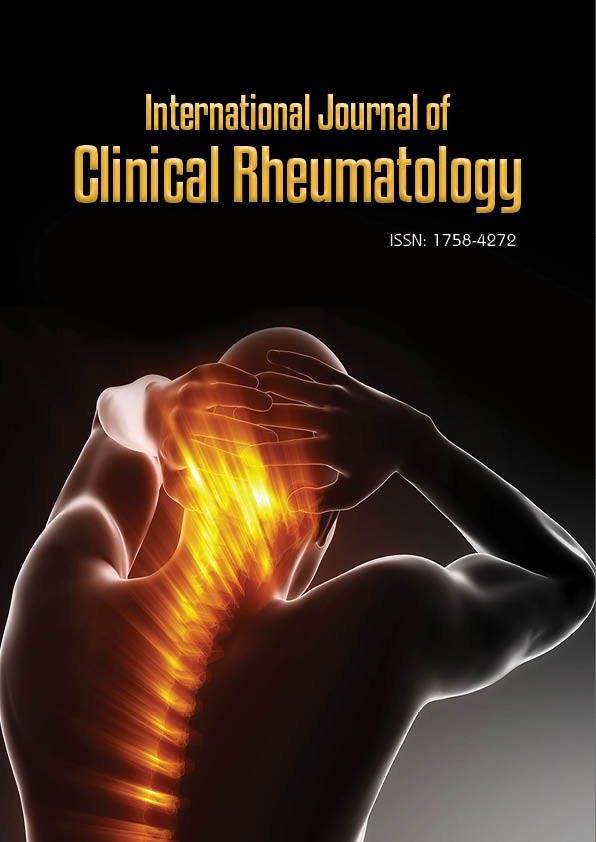Short Communication - International Journal of Clinical Rheumatology (2024) Volume 19, Issue 7
Navigating Joint Pain: Causes, Symptoms, and Comprehensive Management
David Brown*
Paediatric Rheumatology Unit, Hospital Infantile Universitario Niño Jesús, Madrid, japan
- *Corresponding Author:
- David Brown
Paediatric Rheumatology Unit, Hospital Infantile Universitario Niño Jesús, Madrid, japan
E-mail: david.brown@gmail.com
Received: 01-Jul-2024, Manuscript No. fmijcr-24-150650; Editor assigned: 03- Jul-2024, Pre-QC No. fmijcr-24-150650 (PQ); Reviewed: 16-Jul-2024, QC No. fmijcr-24-150650; Revised: 22- Jul-2024, Manuscript No. fmijcr-24-150650 (R); Published: 29- Jul-2024, DOI: 10.37532/1758- 4272.2024.19(7).236-239
Abstract
Joint pain is a widespread issue that affects individuals of all ages and backgrounds, significantly impacting daily activities and overall quality of life. This article provides an in-depth exploration of joint pain, investigating its myriad causes, common symptoms, and effective management strategies. We examine a range of factors contributing to joint pain, including inflammatory conditions such as arthritis, degenerative diseases like osteoarthritis, injuries, and autoimmune disorders. Recognizing key signs—such as pain, swelling, and decreased mobility—is essential for accurate diagnosis and timely intervention. The article details essential diagnostic methods, including thorough physical examinations and advanced imaging studies, which aid in identifying the underlying causes of joint pain. Management strategies are discussed comprehensively, covering pharmacological treatments, physical therapy, lifestyle changes, and, when necessary, surgical options. Emphasizing prevention, the article highlights the importance of adopting a healthy lifestyle—incorporating regular exercise, balanced nutrition, and protective measures—to maintain joint health and reduce the risk of future issues. Additionally, we address the psychological impact of chronic joint pain and the importance of holistic approaches in treatment. By providing a thorough understanding of joint pain and its complexities, this article aims to empower individuals to proactively manage this common health concern. With awareness and knowledge, readers can take informed steps toward alleviating joint pain and improving their overall well-being. Ultimately, this comprehensive examination seeks to foster greater understanding and dialogue around joint health, encouraging both individuals and healthcare providers to prioritize effective management and preventive strategies.
Keywords
Joint pain â Arthritis
Introduction
Joint pain is a pervasive and often debilitating condition that affects individuals across diverse demographics, significantly impacting their quality of life. As a prevalent symptom rather than a specific ailment, joint pain manifests in various forms, arising from an array of causes, including inflammatory conditions, degenerative diseases, injuries, and autoimmune disorders [1]. Understanding the complexities of joint pain, from its anatomical origins to the nuanced range of symptoms, is paramount for both individuals experiencing discomfort and healthcare professionals seeking to provide effective interventions. This article, titled "Decoding Joint Pain: Causes, Symptoms, and Strategies," aims to unravel the intricacies surrounding joint pain, offering insights into its diverse etiologies and exploring the common symptoms that individuals may encounter. Furthermore, we will delve into the diagnostic methods employed to identify the root causes of joint pain, ranging from physical examinations to advanced imaging studies [2]-[4]. By examining the various strategies for managing joint pain, including medication, physical therapy, and lifestyle adjustments, this article aims to provide a comprehensive resource for those seeking to understand and navigate the challenges posed by joint pain [5]. As we unravel the complexities of joint pain, we embark on a journey to empower individuals with knowledge, equipping them to make informed decisions about their health and well-being. Whether it's adopting preventive measures, seeking timely medical intervention, or exploring lifestyle modifications, this exploration into joint pain strives to be a valuable resource for fostering a proactive and informed approach to musculoskeletal health [6]. Joint pain is a common ailment that affects people of all ages, often impairing their daily activities and diminishing their quality of life. It is a symptom rather than a specific condition, and its causes can vary widely, ranging from injury and inflammation to underlying medical conditions. In this article, we will explore the intricacies of joint pain, examining its causes, symptoms, and potential management strategies [7].
Anatomy of joints
To comprehend joint pain, it is crucial to have a basic understanding of the anatomy of joints. Joints are the connections between bones that allow for movement and provide structural support to the body. The ends of bones are covered with cartilage, and synovial fluid lubricates the joint, enabling smooth movement. Ligaments and tendons further stabilize the joints, ensuring their proper function.
Causes of joint pain
Inflammation: Inflammatory joint diseases, such as rheumatoid arthritis and lupus, can lead to chronic joint pain. Inflammation caused by infections, like Lyme disease or viral arthritis, can also affect the joints [8].
Degeneration: Osteoarthritis is a common form of joint pain resulting from the degeneration of cartilage, leading to bone-on-bone contact and pain.
Injury: Acute injuries, such as fractures, dislocations, or sprains, can cause immediate joint pain.
Overuse injuries, often seen in athletes, may lead to chronic joint pain.
Autoimmune disorders: Conditions like rheumatoid arthritis and ankylosing spondylitis involve the immune system attacking the joints, causing inflammation and pain.
Metabolic conditions: Gout, a type of arthritis, is caused by the accumulation of uric acid crystals in the joints, resulting in severe pain and inflammation [10].
Infectious diseases: Certain infections, like septic arthritis, can directly affect the joints, causing pain and swelling.
Symptoms of joint pain
Pain: Joint pain can range from mild discomfort to severe, debilitating pain.
Swelling: Inflammation often accompanies joint pain, leading to swelling and a feeling of warmth in the affected area.
Stiffness: Joint stiffness, especially after periods of inactivity, is a common symptom of various joint conditions.
Reduced range of motion: Conditions affecting the joints can limit the normal range of motion, making it difficult to perform daily activities.
Diagnosis and medical evaluation
Physical examination: A thorough examination by a healthcare professional can help identify the location, severity, and potential causes of joint pain.
Imaging studies: X-rays, MRI, and CT scans can provide detailed images of the joints, aiding in the diagnosis of conditions like arthritis or structural abnormalities.
Laboratory tests: Blood tests may be conducted to check for markers of inflammation, antibodies, or the presence of certain metabolic conditions.
Management strategies
Medication: Nonsteroidal anti-inflammatory drugs (NSAIDs), analgesics, and disease-modifying antirheumatic drugs (DMARDs) may be prescribed to manage pain and inflammation [9].
Physical therapy: Targeted exercises can help improve joint flexibility, strengthen supporting muscles, and alleviate pain.
Lifestyle modifications: Maintaining a healthy weight, engaging in regular low-impact exercises, and avoiding activities that exacerbate joint pain can be beneficial.
Joint injections: Corticosteroid injections directly into the joint can provide relief from inflammation and pain.
Surgery: In severe cases or when conservative measures fail, surgical interventions like joint replacement may be considered.
Preventive measures: Maintain a Healthy Lifestyle: Adopting a balanced diet, regular exercise, and proper hydration can contribute to overall joint health.
Protective measures: Using proper techniques during physical activities and avoiding overuse or strain can help prevent joint injuries.
Regular check-ups: Periodic health check-ups can aid in the early detection and management of conditions contributing to joint pain.
Conclusion
In conclusion, "Decoding Joint Pain: Causes, Symptoms, and Strategies" has illuminated the intricate landscape of joint pain, shedding light on its multifaceted nature and the myriad factors contributing to its prevalence. Joint pain, often symptomatic of underlying conditions, encompasses a spectrum of causes ranging from inflammatory responses and degenerative diseases to injuries and autoimmune disorders. Recognizing the symptoms, such as pain, swelling, and reduced mobility, is pivotal for early intervention and effective management. The journey through this exploration has underscored the importance of accurate diagnosis, with physical examinations and advanced imaging techniques playing crucial roles in identifying the root causes of joint pain. The article has provided a comprehensive overview of various management strategies, encompassing medication, physical therapy, lifestyle adjustments, and, in severe cases, surgical interventions. By understanding these strategies, individuals can work collaboratively with healthcare professionals to tailor approaches that align with their specific needs.
References
- Kato H, Nakajima M (2013) Treatments for esophageal cancer: a review. Gen Thorac Cardiovasc Surg 61: 330-335.
- Then EO, Lopez M, Saleem S, Gayam V, Sunkara T, et al. (2020) Esophageal Cancer: An Updated Surveillance Epidemiology and End Results Database Analysis. World J Oncol 11: 55-64.
- Jeffrey PD, Russo AA, Polyak K, Gibbs E, Hurwitz J, et al. (1995) Mechanism of CDK activation revealed by the structure of a cyclinA-CDK2 complex. Nature 376: 313-320.
- Pagano M (2004) Control of DNA synthesis and mitosis by the Skp2-p27-Cdk1/2 axis. Mol Cell 14: 414-416.
- Odle RI, Walker SA, Oxley D, Kidger AM, Balmanno K, et al. (2020) An mTORC1-to-CDK1 Switch Maintains Autophagy Suppression during Mitosis. Mol Cell 77: 228-240 e227.
- Tong Y, Huang Y, Zhang Y, Zeng X, Yan M, et al. (2021) DPP3/CDK1 contributes to the progression of colorectal cancer through regulating cell proliferation, cell apoptosis, and cell migration. Cell Death Dis 12: 529.
- Li L, Wang J, Hou J, Wu Z, Zhuang Y, et al. (2012) Cdk1 interplays with Oct4 to repress differentiation of embryonic stem cells into trophectoderm. FEBS Lett 586: 4100-4107.
- Marlier Q, Jibassia F, Verteneuil S, Linden J, Kaldis P, et al. (2018) Genetic and pharmacological inhibition of Cdk1 provides neuroprotection towards ischemic neuronal death. Cell Death Discov 4: 43.
- Gregg T, Sdao SM, Dhillon RS, Rensvold JW, Lewandowski SL, et al. (2019) Obesity-dependent CDK1 signaling stimulates mitochondrial respiration at complex I in pancreatic beta-cells. J Biol Chem 294: 4656-4666.
- Smith HL, Southgate H, Tweddle DA, Curtin NJ (2020) DNA damage checkpoint kinases in cancer. Expert Rev Mol Med 22: e2.
Indexed at, Google Scholar, Crossref
Indexed at, Google Scholar, Crossref
Indexed at, Google Scholar, Crossref
Indexed at, Google Scholar, Crossref
Indexed at, Google Scholar, Crossref
Indexed at, Google Scholar, Crossref
Indexed at, Google Scholar, Crossref
Indexed at, Google Scholar, Crossref
Indexed at, Google Scholar, Crossref


